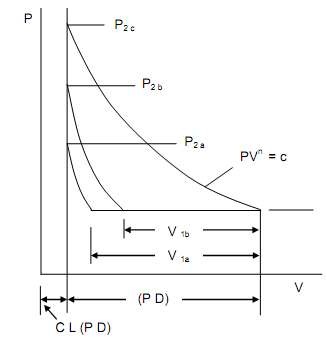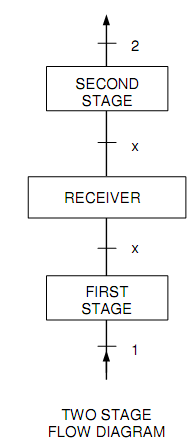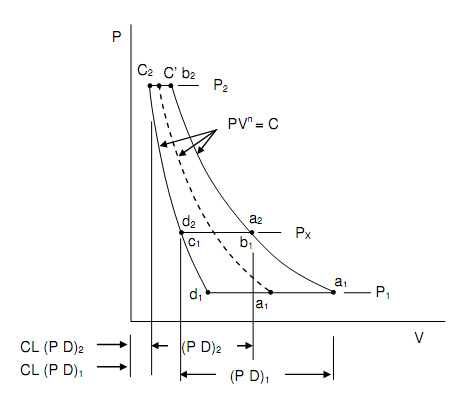Volumetric Efficiency And Pressure Ratio
It is apparent that as the pressure ratio raises the volumetric efficiency of a compressor of permanent clearance reduces, ultimately becoming zero. This can also be observed in an indicator diagram shown in figure below. Since the discharge pressure is raised, the volume V1, taken in at p1, reduces. At certain pressure p2c the compression line intersects the line of clearance volume and is no discharge of gas. An effort to pump to I2c (or any high pressure) would outcome in re-expansion and compression of the same gas constantly, with no flow in or out.
The maximum pressure ratio achievable with reciprocating compressor cylinder is then observed to be limited by the clearance; there are economic and practical limits to the decrease of clearance; whenever such limits interfere with the achievement of the preferred discharge pressure. It is essential to use multistage compression. In a multistage compressor the gas is passed in sequence via two or more compressors, or phases, each of which works on a small pressure ratio. Dis-regarding pressure losses among phases, the total pressure ratio is the product of the pressure ratios of the phases.

Figure: Effect of Pressure on Capacity
Figure shown below illustrates the comparative idealized indicator diagrams for the compression of gas from p1 to p2 by a two phase machine or by a single phase machine of the similar piston displacement and clearance as the initial phase of the two phase machine.
The single phase machine compacts gas from a1 to b2, discharge at p2 from to c′, expands from c′ to d′, and acquire in gas from d1 to a1. Therefore, the capacity per machine cycle is Va1 – V′d.
The initial phase of the two phase machine compresses gas from a1 to b1, discharge at px from b1 to c1, expands from c1 to d1, and acquires in gas at p1 from d1 to a1. The capacity per machine cycle is Va1 – Vd1 that is noticeably larger than the capability of the single stage machine.
The second stage acquired in gas from d1 to a2 (that coincide with c1 – b1), compresses from a1 to b2, discharges at p2 from b2 to c2, and expands from c2 to d2. The flow capacity of the two stage machine is the capacity of the initial stage, as all the gas is taken in by the initial stage.


Figure: Two-stage Compression
The two stage compressor has bigger capacity than the single stage compressor of the similar clearance, at similar pressure ratio P2/P1. This benefit is bigger at larger pressure ratios, and at adequately large pressure ratios the single stage compressor becomes too expensive since of the low volumetric efficiency.